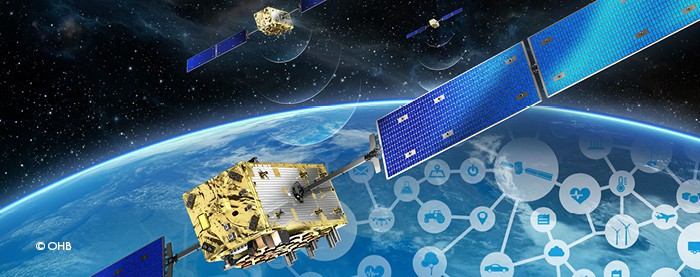Can you imagine what a popular Italian dessert has to do with revolutionising the logistics sector? What sounds crazy is high-tech reality. tiramizoo, the former European Satellite Navigation Competition (ESNC) participant and ESA BIC Bavaria alumni, developed an innovative product – comprising an app, platform and smart back-end technology – which interfaces retailers with customers to schedule local delivery services of their purchases. This enables better service to customers, reduces costs and relieves urban traffic congestion in over 150 cities in Germany, Austria, Sweden and The Netherlands.
Location Based Services Boosting IoT
tiramizoo is a prime application example that makes smart use of Global Satellite Navigation System (GNSS) data in combination with the Internet of Things (IoT) to further improve logistics on the global scale. Moreover, location determination is crucial in many IoT applications – including asset tracking, vehicle monitoring and wearable devices. Satellite positioning is the most accurate method for doing exactly that. GNSS offers real-time geolocation and timing information to countless applications in multiple market segments.
All Logistics Stakeholders Benefit from GNSS
Logistics and Location Based Services (LBS) are two predestined market segments that use big benefits from integrating GNSS in future IoT infrastructures. LBS include a multitude of customised applications supported by numerous sorts of devices: Smartphones and tablets, personal tracking devices, wearables, digital cameras and portable computers. By connecting these kind of devices, vehicles and infrastructure with people all over cities, authorities and industry are able to highly increase efficiency and sustainability, resulting from saving time and money, as well as enhancing interaction. Key advantages of IoT spreading in logistics comprise the provision of identity, location, and other tracking information, all the way from the manufacturer to the retailer. Combining real-time sensor data with environmental data enables efficient decision-making to push the overall productivity.
GNSS provides major benefits for multimodal logistics by improving efficiency, security and safety. Everybody in this sector – including logistics service providers, transportation network managers as well as customs and port authorities – profit from these important benefits: They are able to better monitor cargo along the whole supply chain, from the consignee to the consignor. Additionally, to lowered costs and increased transport safety! Furthermore, the risk of theft and attacks during transport is drastically reduced. How does it work? It’s easy, because the containers are equipped with smart GNSS devices always giving precise tracking and tracing information of the valuable freight.
Logistics service providers have the choice of buying them or signing leasing/renting contracts with the respective service providers. Isn’t that very convenient?
Europe’s Urge to Push Sustainable Transport
Logistics play a critical role for sustainable and competitive mobility and safety. That’s why Europe has to exploit the benefits of technological progress which result in constant change for citizens, businesses and governments. Not for nothing, a digital Europe and free movement of data are major priorities of the Estonian Presidency of the Council of the European Union (EU). What does that entail?
- developing cross-border e-commerce and e-services for the benefit of consumers, producers and businesses
- ensuring modern and secure electronic communications available everywhere across Europe as well as creating a favourable environment for new innovative services
- advancing cross-border digital public services to facilitate everyday life*
Speaking about everyday life: The ESNC is constantly searching for sustainable innovations and solutions for daily life, based on GNSS. One ultimate goal is to improve logistics worldwide. This year’s most brilliant business cases making use of valuable GNSS data will be awarded in Tallinn, Estonia, within the European Space Week 2017. Come to Tallinn to witness this year’s latest innovations based on satellite navigation that can make the world a better, more connected and sustainable place.
About the Satellite Masters Conference
Clear your calendar to experience the most brilliant EO applications and solutions at this year’s Satellite Masters Conference in Tallinn, Estonia, 7-9 November 2017. It incorporates the Awards Ceremony of Europe’s major ideas competitions for commercial space applications – the European Satellite Navigation Competition (ESNC) and the Copernicus Masters – as well as the Horizon 2020 Space Info Day within the European Space Week. The Satellite Masters Conference hosts the most important decision makers from industry, politics and academia. Pre-register now and stay tuned for continuous updates at satellite-masters-conference.eu.
*source: www.eu2017.ee/priorities-estonian-presidency#data




